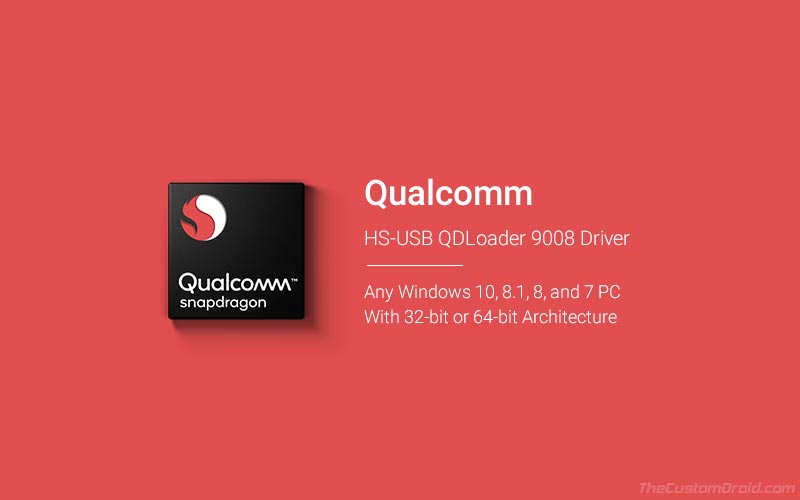-->
A device interface is a symbolic link to a Plug and Play (PnP) device that an application can use to access the device. A user-mode application can pass the interface's symbolic link name to an API element, such as the Microsoft Win32 CreateFile function. To obtain a device interface's symbolic link name, the user-mode application can call SetupDi functions. For more information about SetupDi functions, see Using Device Installation Functions.
Each device interface belongs to a device interface class. For example, a driver stack for a CD-ROM device might provide an interface that belongs to the GUID_DEVINTERFACE_CDROM class. One of the CD-ROM device's drivers would register an instance of the GUID_DEVINTERFACE_CDROM class to inform the system and applications that a CD-ROM device is available. For more information about device interface classes, see Overview of Device Interface Classes.



Registering a Device Interface
- Qualcomm HS-USB QDLoader USB Driver is a tool that is important to connect your Snapdragon processor powered device with a Windows computer. As most popular brands use Qualcomm Snapdragon chipsets on their devices, installing the Qualcomm USB Driver is necessary.
- Download Mobile USB Driver for all Android devices for Windows Qasim Tricks June 19, 2020 Installing USB Driver of your mobile for Windows is very important if you want to use an ADB driver or if you are using Odin for Samsung.
To register an instance of a device interface class, a framework-based driver can call WdfDeviceCreateDeviceInterface from within its EvtDriverDeviceAdd callback function. If the driver supports multiple instances of the interface, it can assign a unique reference string to each instance.
After the driver has registered a device interface, the driver can call WdfDeviceRetrieveDeviceInterfaceString to obtain the symbolic link name that the system has assigned to the device interface.
For information about other ways that drivers can register device interfaces, see Registering a Device Interface Class.

Enabling and Disabling a Device Interface
The camera control API is an automation component that communicates with the camera device driver and exports a COM automation interface. COM automation provides an interface that allows Microsoft Office, VB, VBA, C, and other Windows applications to control the camera.
After a driver calls WdfDeviceCreateDeviceInterface from EVT_WDF_DRIVER_DEVICE_ADD, the framework automatically enables all of a device's interfaces when the device goes through PnP enumeration and disables the interfaces when the device undergoes PnP removal.
Note that any device power state changes or PnP resource rebalance does not change the interface's state. To prevent the interface from being automatically enabled during PnP start, call WdfDeviceSetDeviceInterfaceStateEx (set the EnableInterface parameter to FALSE) for that interface.
Interfaces created after the device already starts won't be automatically enabled. The driver must call WdfDeviceSetDeviceInterfaceState or WdfDeviceSetDeviceInterfaceStateEx to enable such interfaces.
A driver can disable and re-enable a device interface if necessary. For example, if a driver determines that its device has stopped responding, the driver can call WdfDeviceSetDeviceInterfaceState or WdfDeviceSetDeviceInterfaceStateEx to disable the device's interfaces and prohibit applications from obtaining new handles to the interface. (Existing handles to the interface are not affected.) If the device later becomes available, the driver can call WdfDeviceSetDeviceInterfaceState or WdfDeviceSetDeviceInterfaceStateEx again to reenable the interfaces.
Receiving Requests to Access a Device Interface
When an application or kernel-mode component requests access to a driver's device interface, the framework calls the driver's EvtDeviceFileCreate callback function. The driver can call WdfFileObjectGetFileName to obtain the name of the device or file that the application or kernel-mode component is accessing. If the driver specified a reference string when it registered the device interface, the operating system includes the reference string in the file or device name that WdfFileObjectGetFileName returns.
Accessing Another Driver's Device Interface
This section shows how a Kernel-Mode Driver Framework (KMDF) driver or a User-Mode Driver Framework (UMDF) version 2 driver registers for notification of arrival or removal of a device interface provided by another driver, and then creates a remote I/O target to communicate with the device represented by the device interface.

For information on how to do this in a UMDF version 1 driver, see Using Device Interfaces in UMDF Drivers.
To register for notification of device interface events, a KMDF driver calls IoRegisterPlugPlayNotification, while a UMDF 2 driver calls CM_Register_Notification. In both cases, the driver calls the appropriate routine from its EvtDriverDeviceAdd callback function.
The following code example shows how a local UMDF 2 driver registers for notifications and then opens the remote I/O target.
Drivers Qs Industries Usb Devices Adapter
The remote driver registers for a device interface by calling WdfDeviceCreateDeviceInterface from EvtDriverDeviceAdd.
The local driver calls CM_Register_Notification from EvtDriverDeviceAdd to register for notification when a device interface is available. Provide a pointer to a notification callback routine that the framework calls when device interfaces are available.
The system calls the local driver's notification callback routine each time that the specified device interface arrives or is removed. The callback routine can examine the EventData parameter to determine which device interface has arrived. It might then queue a work item to open the device interface.
From the work item callback function, the local driver calls WdfIoTargetCreate to create the remote target, and WdfIoTargetOpen to open a remote I/O target.
When calling WdfIoTargetOpen, the driver optionally registers an EvtIoTargetQueryRemove callback function to receive removal notification, along with the opportunity to decline the removal. If the driver does not provide EvtIoTargetQueryRemove, the framework closes the I/O target when the device is removed.
In rare cases, a UMDF 2 driver can call CM_Register_Notification a second time, to register for notification of device removal. For example, if the driver calls CreateFile to get a HANDLE to the device interface, it should register for notification of device removal so that it can properly respond to query remove attempts. In most cases, the UMDF 2 driver calls CM_Register_Notification only once, and relies on WDF support for device removal.